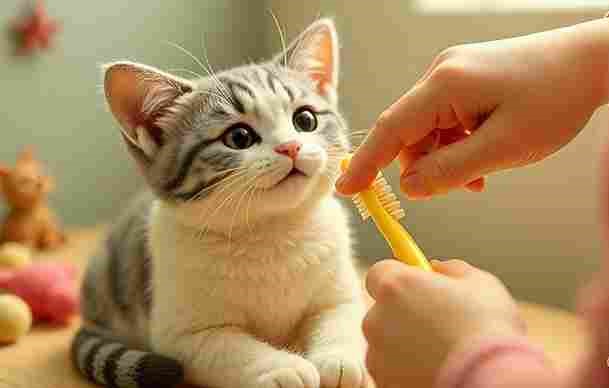Yes, you should brush your cat’s teeth on a regular basis. Regularly brushing your cat’s teeth can help you avoid serious dental problems, painful infections, and expensive vet bills. Most cats over 3 years old already have gum disease, but brushing your cat’s teeth every day can help keep them healthy and free of pain.
Cats often don’t get the dental care they need, but it’s just as important as feeding and grooming. We’ll talk in detail about how often to brush, how to do it safely, what happens if you don’t, and why it’s never too late to start in this guide.
Quick Summary
- Brush your cat’s teeth daily or at least 3 times per week
- Use cat-specific toothpaste—never human kind!
- Skipping brushing can cause dental disease, pain, and organ infections
- Start slow, be gentle, and reward your cat
- Dental treats, wipes, and vet cleanings can help, but brushing is best
Table of Contents
Why Should You Brush Your Cat’s Teeth?
Brushing your cat’s teeth removes the deposits of food particles, plaque, and bacteria that can lead to issues with dental health. Plaque becomes into tartar if you don’t clean your teeth regularly. This can cause gum disease, infections, and tooth loss.
Common Dental Problems in Cats:
- Gingivitis – Red, swollen, bleeding gums
- Periodontal Disease – Infection and decay around the teeth
- Tooth Resorption – Painful decay of the tooth structure (very common in cats)
- Halitosis – Chronic bad breath caused by bacteria
- Systemic Infections – Oral bacteria can enter the bloodstream and affect the heart, liver, or kidneys
The American Veterinary Medical Association (AVMA) says that more than 70% of cats will have dental problems by the time they are three years old. That’s why brushing your cat at home is so important for their health.
🗓️ How Often Should You Brush Your Cat’s Teeth?
Brushing your cat’s teeth every day is best, but brushing them 2–3 times a week is still a big help. The more you do it, the more your cat will get used to it, and the less plaque you’ll have.
- Daily Brushing: Best for plaque prevention and routine care.
- Every Other Day: Acceptable if you also use dental chews or water additives.
- Less Than Weekly: Better than nothing, but dental disease may still occur.
💡 Pro Tip:If you don’t have much time, just brush your cat’s back teeth. These teeth get the most plaque and are the most likely to decay.
you might like: Why Do Cats Meow So Much in Heat? Vet-Backed Reasons & Calming Tips
🧴 Can You Use Regular Toothpaste on Cats?
No! You should never use human toothpaste on cats.
Fluoride, baking soda, and xylitol are all toxic to cats, so toothpaste made for humans is not safe for them. Even a little bit can make you throw up, hurt the liver, or have a seizure.
Safe Toothpaste for Cats:
- Specifically labeled as cat-safe or pet-safe
- Comes in cat-friendly flavors like poultry, tuna, salmon, or beef
- Does not foam (non-foaming formulas are safer for swallowing)
Most pet stores and vet clinics carry cat-friendly dental products. Brands like Virbac C.E.T., Vet’s Best, and Sentry Petrodex are often recommended by veterinarians.
Are You Supposed to Brush Your Cat’s Teeth?
Yes, without a doubt. Brushing is crucial for your cat’s long-term health, even if they don’t exhibit any symptoms. Over time, plaque may build up quietly, causing serious issues that might not become apparent until they are advanced.
It’s a common misconception among cat owners that dry kibble is sufficient for cleaning their felines’ teeth. Crunchy food by itself is ineffective at removing plaque or breaking down tartar. The best dental care for cats is brushing.
Read more: How to Groom a Long-Haired Cat at Home (Simple Tips for Real Pet Parents)
👣 How to Brush Your Cat’s Teeth (Step-by-Step Guide)
Brushing your cat’s teeth can seem tricky, but with practice and patience, most cats learn to accept it.
Step 1: Gather the Right Tools
- Cat toothbrush (long-handled or finger brush)
- Cat toothpaste (never human toothpaste)
- A calm, quiet area
- Your cat’s favorite treats or toy for rewards
Step 2: Get Your Cat Comfortable
- Gently pet your cat and talk in a soothing voice.
- Let your cat sniff and taste the toothpaste first.
- Try touching their lips and gums with your finger.
Step 3: Start Brushing
- Lift your cat’s upper lip and brush in small, circular motions.
- Focus on the outside surfaces of the teeth (inside is less important).
- Start with a few seconds, then gradually increase brushing time.
Step 4: Reward and Repeat
- Give a treat or cuddle after brushing.
- Aim to build a daily habit at the same time each day.
🧡 Don’t force it! If your cat struggles, try brushing just one side and finish later.
What Happens If You Don’t Brush Your Cat’s Teeth?
If you ignore this best practice, dental care, it can lead to serious health consequences for your cat.
Without brushing:
- Tartar builds up, causing painful gum inflammation
- Bacteria enter the bloodstream, harming organs like the kidneys and heart
- Tooth loss may occur, making it hard to eat
- Chronic pain can lead to behavior changes like hiding or irritability
Eventually, your cat may need professional dental cleaning under anesthesia, which is expensive and risky for older cats.
Extra Dental Care Tips (If Your Cat Hates Brushing)
Not all cats love having their teeth brushed. If brushing is impossible, these options can help:
- Dental treats: Look for products approved by the Veterinary Oral Health Council (VOHC).
- Water additives: Flavorless liquids added to drinking water to reduce plaque.
- Dental wipes: Wipe the teeth and gums as a gentler alternative to brushing.
- Professional vet cleanings: Performed under anesthesia once a year.
Remember, these are helpful tools—but they’re not as effective as brushing.
FAQ
1. Do cats really need their teeth brushed?
Yes. Just like humans, cats need dental care to avoid gum disease and other health issues.
2. How can I get my cat to tolerate brushing?
Start slow. Use a flavored toothpaste, and let your cat explore the toothbrush. Reward often!
3. My cat eats dry food—do I still need to brush?
Yes. Dry food does not remove plaque effectively. Brushing is still needed.
4. How early should I start brushing?
Start brushing as early as 6 months old. It’s easier to create habits in kittens.
5. What if my cat won’t let me brush their teeth?
Try dental wipes or treats, and talk to your vet about professional cleanings.

Karim Kaifi is an experienced pet owner and writer. He shares practical, research-backed advice based on over 10 years of caring for cats and dogs.






